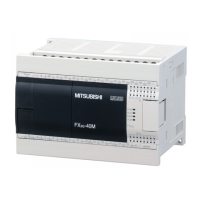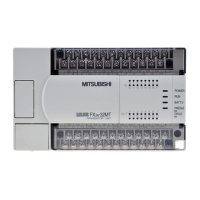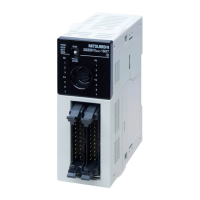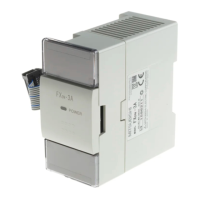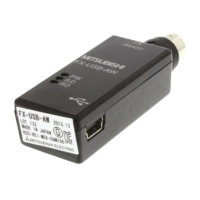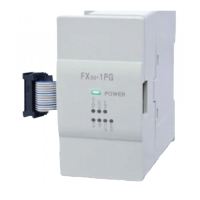853
FX3G/FX3U/FX3UC Series Programmable Controllers
Programming Manual - Basic & Applied Instruction Edition
36 Interrupt Function and Pulse Catch Function
36.2 Common Items
31
FNC275-FNC279
Data
Transfer 3
32
FNC280-FNC289
High Speed
Processing 2
33
FNC290-FNC299
Extension File
Register
34
FNC300-FNC305
FX
3U
-CF-ADP
35
SFC•STL
Programming
36
Interrupt
Function
37
Special Device
38
Error Code
A
Version Up
Information
B
Execution Times
36.2.3 Cautions on use (common)
This section explains common cautions on using the interrupt function or pulse catch function.
Specific cautions on each interrupt function are explained in the description of each interrupt function.
1. Processing when many interrupts are generated
When many interrupts are generated in turn, priority is given to the first one. When many interrupts are
generated at the same time, priority is given to the one having the smallest pointer number.
While an interrupt routine is being executed, other interrupts are disabled.
2. When double interrupt (interrupt during another interrupt) is required [interrupt function]
Usually, interrupts are disabled in an interrupt routine (program).
When the EI (FNC04) and DI (FNC05) instructions are programmed in an interrupt routine in FX
3U/FX3UC
PLCs, up to two interrupts can be accepted.
Double interrupts are not available in FX
3G PLCs.
3. Operation when a timer is used [interrupt function]
Make sure that counting using a general timer is disabled, even a 1ms retentive type timer.
In an interrupt routine, use timers for routine program T192 to T199.
4. Non-overlap of input [input interrupt (with/without delay function) and pulse catch function]
The inputs X000 to X007 can be used for high speed counters, input interrupts, pulse catch, SPD, ZRN,
DSZR and DVIT instructions and for general-purpose inputs.
Make sure inputs do not overlap with each other.
When using SFC program (STL instruction), do not drive state relays S in SET or OUT instruction in an
interrupt program.
5. When using SFC program (STL instruction)
When using SFC programs (STL instruction), do not drive state relays S using SET or OUT instructions in an
interrupt program.
6. Operation of devices latched in the ON status [interrupt function]
Devices which were set to ON in an interrupt routine are held in the ON status even after the interrupt routine
is finished.
When RST instruction for a timer or counter is executed, the reset status of the timer or counter is also held.
To turn OFF a device held in the ON status or for canceling such a timer or counter held in the reset status,
reset such a device or deactivate RST instruction respectively inside or outsite the routine.
Example in which outputs are latched
In the program example shown below, the counter C0 is provided to count X001. When X001 turns ON
from OFF, the interrupt program I001 is executed only in one scan, and then the counter C0 is reset and
Y007 is output.
1) Program example
M8000
K10
FNC 04
EI
C0
RST C0
X001
FNC 06
FEND
FNC 05
IRET
I001
Y007
Step 0

